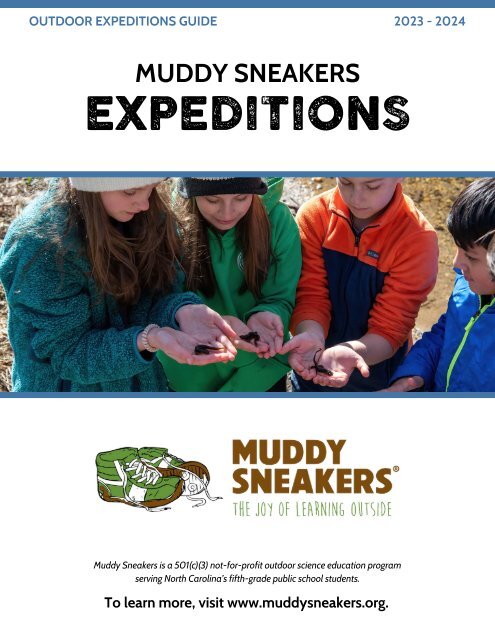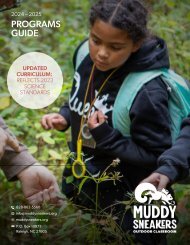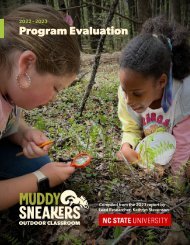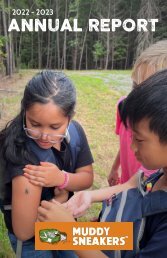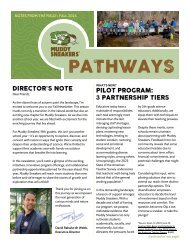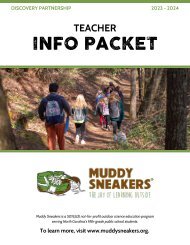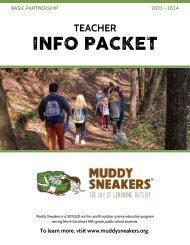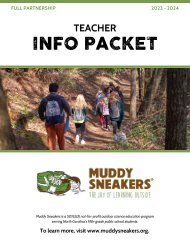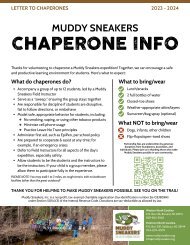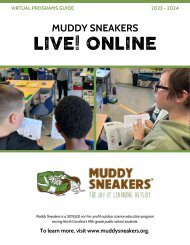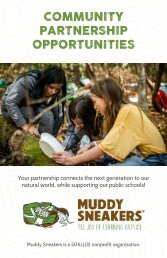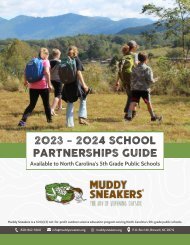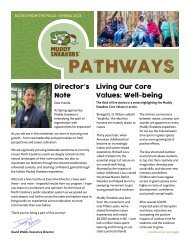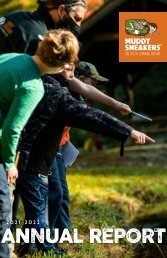2023 - 2024 Muddy Sneakers Expedition Guide
The 2023 - 2024 Muddy Sneakers Expedition Guide offers and overview of each expedition available this school year. For each topic, you'll find information about what to expect including sample activities, NC Essential Science Standard correlation, and vocabulary terms.
The 2023 - 2024 Muddy Sneakers Expedition Guide offers and overview of each expedition available this school year. For each topic, you'll find information about what to expect including sample activities, NC Essential Science Standard correlation, and vocabulary terms.
Create successful ePaper yourself
Turn your PDF publications into a flip-book with our unique Google optimized e-Paper software.
OUTDOOR EXPEDITIONS GUIDE <strong>2023</strong> - <strong>2024</strong><br />
MUDDY SNEAKERS<br />
EXPEDITIONS<br />
<strong>Muddy</strong> <strong>Sneakers</strong> is a 501(c)(3) not-for-profit outdoor science education program<br />
serving North Carolina’s fifth-grade public school students.<br />
To learn more, visit www.muddysneakers.org.
OUTDOOR EXPEDITIONS GUIDE OVERVIEW<br />
3<br />
5<br />
8<br />
11<br />
CONTENTS<br />
DAY 1: SCHOOL IN THE<br />
WOODS<br />
AQUATIC ECOSYSTEMS<br />
Standards<br />
Vocabulary<br />
ENERGY & HEAT<br />
TRANSFER<br />
Standards<br />
Vocabulary<br />
FORCES & MOTION<br />
Standards<br />
Vocabulary<br />
14 INHERITANCE ADAPTATION<br />
&<br />
Standards<br />
Vocabulary<br />
17<br />
LIVING SYSTEMS<br />
Standards<br />
Vocabulary<br />
20 MATTER<br />
Standards<br />
Vocabulary<br />
23 TERRESTRIAL<br />
ECOSYSTEMS<br />
Standards<br />
Vocabulary<br />
26 WEATHER<br />
Standards<br />
Vocabulary<br />
29<br />
PREPARING FOR YOUR<br />
EXPEDITION<br />
6<br />
7<br />
9<br />
10<br />
12<br />
13<br />
15<br />
16<br />
18<br />
19<br />
21<br />
22<br />
24<br />
25<br />
27<br />
28<br />
What are <strong>Muddy</strong> <strong>Sneakers</strong> <strong>Expedition</strong>s?<br />
<strong>Muddy</strong> <strong>Sneakers</strong> Outdoor <strong>Expedition</strong>s are fullday<br />
or half-day learning adventures, facilitated<br />
by a <strong>Muddy</strong> <strong>Sneakers</strong> Instructor, that take place<br />
either on the schoolyard or on nearby<br />
conserved lands.<br />
What's in this guide?<br />
This guide provides an overview of each<br />
expedition available. For each topic, you'll find<br />
information about what to expect, including:<br />
Sample activities<br />
Activities accompanied by an asterisk<br />
(*) are most likely to take place during<br />
the expedition.<br />
NC Essential Science Standard Correlation<br />
Vocabulary<br />
How to use this guide:<br />
Each <strong>Muddy</strong> <strong>Sneakers</strong> partnership includes a<br />
predetermined number of expeditions.*<br />
At the beginning of your partnership, your<br />
school's Lead Teacher will schedule your year<br />
of expeditions, including topic and location.<br />
Use this guide to select your expeditions.<br />
While science is our focus, activities support<br />
cross-curricular state standards, as noted by<br />
the following key:<br />
Science<br />
ELA<br />
Math<br />
Art<br />
Mental & Emotional Health<br />
Healthful Living/Physical Education<br />
Collaboration & Communication<br />
Cognitive; Critical Thinking & Problem-Solving<br />
*<strong>Expedition</strong>s can be added for an additional fee.
DAY 1: SCHOOL IN THE WOODS<br />
RESPECT CIRCLE<br />
EXPEDITION ACTIVITIES<br />
<strong>Muddy</strong> <strong>Sneakers</strong> is built on 3 main principles for a successful day in the woods: Safety,<br />
Learning and Fun. This activity will help students understand how they reach all three<br />
goals by committing to acting respectfully to the environment, each other, and to<br />
ourselves.<br />
STUDENT LEADERSHIP<br />
Working with a small group in the outdoors is an ideal setting for students to develop<br />
leadership skills. Students may work with a partner to take on leadership roles including<br />
navigating, practicing leave no trace, accounting for all group members, watching for<br />
safety hazards, and observing wildlife.<br />
TRAIL NAVIGATION: MAP AND COMPASS SKILLS<br />
An important way to develop leadership among students throughout their <strong>Muddy</strong><br />
<strong>Sneakers</strong> year is to give them the responsibility for trail navigation. In order to lead the<br />
group as the trail navigator on any expedition, students will learn how to use a compass<br />
and how to read a trail map of the expedition site.<br />
*SAFETY ON THE TRAIL<br />
Staying safe during a learning expedition is the top priority of <strong>Muddy</strong> <strong>Sneakers</strong>.<br />
Students will learn to respond appropriately to safety situations that could arise during<br />
a day outdoors: encountering poison ivy, bees, and snakes. Students will also learn the<br />
importance of staying together in a group; and will practice trail etiquette, including<br />
sharing their outdoor “classroom” with hikers, bikes and dogs.<br />
*TAKING CARE OF YOURSELF ON THE TRAIL<br />
Sometimes, expedition sites do not have a public bathroom available. Students will<br />
learn how to use the bathroom outdoors in a way that respects their safety, sanitation,<br />
and privacy, should it become necessary. Students will also learn the importance of<br />
staying hydrated while spending a day outdoors.<br />
DAY 1: SCHOOL IN THE WOODS<br />
*Activities that are most likely to take place during the expedition.<br />
3
*LEAVE NO TRACE<br />
Students should leave their first <strong>Muddy</strong> <strong>Sneakers</strong> expedition with an understanding of<br />
how to leave their outdoor classroom as good or better than they found it. They will<br />
practice traveling through the ecosystem in a low-impact way, and may be introduced<br />
to nationally recognized “Leave No Trace” principles.<br />
*OBSERVATIONS: “I NOTICE, I WONDER, IT REMINDS ME OF…”<br />
In this activity, students will learn skills to make detailed, objective observations, have<br />
meaningful discussions with their classmates, and make connections to prior learning.<br />
SCIENTIFIC INQUIRY<br />
As field scientists, students will engage with the scientific method and hypothesis<br />
testing by conducting an experiment. This activity is designed to introduce students to<br />
the practices of using the outdoors as a learning environment and closely observing<br />
their surroundings. In addition, it aims to acclimate students to sitting in the woods,<br />
writing in their field journals, and listening to their field instructor while taking notes.<br />
Does moss always grow on the north side of a tree?<br />
(Other questions may be explored instead at the instructor’s discretion)<br />
4<br />
DAY 1: SCHOOL IN THE WOODS<br />
*Activities that are most likely to take place during the expedition.
AQUATIC ECOSYSTEMS<br />
EXPEDITION ACTIVITIES<br />
This expedition uses macroinvertebrate bioindicators to test the health of a stream or<br />
river ecosystem. However, this design may not be appropriate in all eco-regions. In<br />
cases where schools do not have access to a free-flowing, freshwater stream, <strong>Muddy</strong><br />
<strong>Sneakers</strong> will adapt the expedition curriculum to correlate with locally-available<br />
ecosystem bioindicators.<br />
*HABITAT OBSERVATION<br />
5.L.2.1<br />
Students observe the differences between terrestrial and aquatic ecosystems, noting<br />
biotic and abiotic factors along the trails they hike to reach their aquatic study site. This<br />
includes discussion of how abiotic factors including water, light and oxygen all shape<br />
the aquatic ecosystem.<br />
POND OR WETLAND STUDY<br />
5.L.2.1, 5.L.2.2<br />
If an accessible pond or wetland is available, students explore the aquatic ecosystem<br />
and the adjacent riparian area. They record observations and discuss the relationship<br />
between these two contiguous ecosystems.<br />
*STREAM STUDY<br />
5.L.2.1, 5.L.2.2, 5.L.2.3<br />
Students learn to identify common macroinvertebrate species in a stream ecosystem,<br />
referring to field guide sheets and playing a matching game with illustrated cards. They<br />
use dip nets and seine nets to capture live specimens from the stream, and count and<br />
categorize these macroinvertebrates to calculate a Stream Health Index value.<br />
How healthy is this stream ecosystem?<br />
How many species of macroinvertebrates live in this stream?<br />
*Activities that are most likely to take place during the expedition.<br />
AQUATIC ECOSYSTEMS<br />
5
WEB OF LIFE GAME<br />
5.L.2.2, 5.L.2.3<br />
Acting out species found during the stream study and others inferred by observation<br />
(raccoon tracks, fishing line, crayfish burrows, etc.), students use ropes to create a<br />
model of a food web for the aquatic ecosystem they have just studied.<br />
REFLECTION: “IF I WERE A STREAM, POND, OR WETLAND”<br />
Practicing creativity and empathy, students imagine themselves in the place of the<br />
ecosystem they have explored, or one of the organisms that lives within it, and create a<br />
poem or written reflection.<br />
AQUATIC ECOSYSTEMS<br />
NC ESSENTIAL STANDARD AND<br />
CLARIFYING OBJECTIVES<br />
5.L.2<br />
5.L.2.1<br />
Understand the interdependence of plants and animals<br />
with their ecosystem.<br />
Compare the characteristics of several common<br />
ecosystems, including estuaries and salt marshes, oceans,<br />
lakes and ponds, forests, and grasslands.<br />
5.L.2.2<br />
Classify the organisms within an ecosystem according to<br />
the function they serve: producers, consumers, or<br />
decomposers (biotic factors).<br />
5.L.2.3<br />
Infer the effects that may result from the interconnected<br />
relationship of plants and animals to their ecosystem.<br />
6<br />
AQUATIC ECOSYSTEMS<br />
*Activities that are most likely to take place during the expedition.
AQUATIC ECOSYSTEMS<br />
VOCABULARY<br />
Abiotic Factors<br />
Aquatic<br />
Biodiversity<br />
Parts of the environment that have never been alive<br />
Water-based<br />
Different types or species of living things<br />
Biotic Factors<br />
Parts of the environment that are alive or were once<br />
alive<br />
Community<br />
Different species of organisms (i.e. populations) that<br />
live in the same area<br />
Ecosystem<br />
All the living and non-living things in a specific area<br />
Habitat<br />
The place occupied by an organism or population that<br />
provides essential resources: food, water, shelter, space<br />
Insect<br />
A six-legged animal with three main body parts (head,<br />
thorax and abdomen) and an exoskeleton<br />
Macroinvertebrate<br />
An animal, without a backbone, large enough to be<br />
seen with your eyes<br />
Metamorphosis<br />
A distinct change in form from one stage to the next in<br />
the life history of an organism<br />
Organism<br />
Population<br />
One individual living thing<br />
Organisms of the same species that live in the same<br />
area<br />
AQUATIC ECOSYSTEMS<br />
7
ENERGY & HEAT TRANSFER<br />
EXPEDITION ACTIVITIES<br />
*CONDUCTION, CONVECTION, RADIATION<br />
BASICS<br />
5.P.3.1, 5.P.3.2<br />
Students will review, or be introduced to, the 3 types of heat transfer:<br />
Conduction: Heat moves between objects that are touching<br />
Convection: Heat moves through a current in liquid or gas<br />
Radiation: Heat moves across a space through rays or waves<br />
CONDUCTION: ROCK PASS<br />
5.P.3.1<br />
Students will observe heat transfer via conduction by playing a sensory awareness<br />
game with small rocks collected along the trail.<br />
*PLANT PERFUMES AND FOREST FLAVORS<br />
5.P.3.1, 5.P.3.2<br />
Students will make either a plant perfume, natural dye, or a foraged pine (or other wild<br />
edible) tea. In the process, students will observe how to safely use a backpacking stove,<br />
and will draw and label the 3 types of heat transfer as water comes to a boil.<br />
RADIATION BOX<br />
5.P.3.1<br />
Students conduct experiments to observe the combined effect of solar radiation and<br />
reflective surfaces on a container of water. They use insulating materials and/or airtight<br />
coverings over the reflective box to prevent heat transfer via conduction or convection,<br />
isolating radiation as a means of heat transfer for their experimental design.<br />
How much will the temperature of water change when placed in a reflective box<br />
(for a set time)?<br />
Will the temperature of water increase more in an open container or in a reflective<br />
box? By how much?<br />
NEST SCAVENGER HUNT<br />
5.P.3.1., 5.P.3.2<br />
8<br />
Students will look for nests, burrows, or other outdoor animal shelters, observing what<br />
designs and materials animals use to insulate themselves from the elements.<br />
ENERGY & HEAT TRANSFER<br />
*Activities that are most likely to take place during the expedition.
*INSULATORS: TEST THE NESTS<br />
5.P.3.1, 5.P.3.2<br />
Students will conduct an experiment by using natural objects to build an insulating<br />
nest for a container of hot water. They will record starting and ending temperatures<br />
over a defined time period (e.g. 20 minute) to calculate the change in temperature.<br />
They will compare the insulating properties of different materials and/or designs, and<br />
discuss heat loss.<br />
Will the water temperature increase, decrease, or stay the same?<br />
How much will the water temperature change over (20) minutes?<br />
What materials do the best job of insulating a container of hot water?<br />
BARE HANDS<br />
5.P.3.2<br />
Students will use the insulating seat-pad in their <strong>Muddy</strong> <strong>Sneakers</strong> backpack to<br />
understand the role of insulators in heat transfer.<br />
ENERGY & HEAT TRANSFER<br />
NC ESSENTIAL STANDARD AND<br />
CLARIFYING OBJECTIVES<br />
5.P.3<br />
5.P.3.1<br />
5.P.3.2<br />
Explain how the properties of some materials change as a<br />
result of heating and cooling.<br />
Explain the effects of the transfer of heat (either by direct<br />
contact or at a distance) that occurs between objects at<br />
different temperatures (conduction, convection or<br />
radiation).<br />
Explain how heating and cooling affect some materials<br />
and how this relates to their purpose and practical<br />
applications.<br />
*Activities that are most likely to take place during the expedition.<br />
ENERGY & HEAT TRANSFER<br />
9
ENERGY & HEAT TRANSFER<br />
VOCABULARY<br />
Energy<br />
The ability to make things move or change<br />
Heat transfer<br />
The movement of heat from a warmer object or area to a<br />
cooler one<br />
Temperature<br />
The measurement of an object’s average heat energy (In<br />
general use: how warm an object is)<br />
Thermal energy<br />
(Heat energy)<br />
The energy of all moving particles that make up all matter<br />
3 TYPES OF HEAT TRANSFER<br />
Conduction<br />
Heat moves between things that are touching<br />
Convection<br />
Heat moves through currents in a liquid or gas<br />
Radiation<br />
Heat moves across a space, through rays or waves<br />
(electromagnetic waves)<br />
10<br />
ENERGY & HEAT TRANSFER
FORCES & MOTION<br />
EXPEDITION ACTIVITIES<br />
*MOTION IN WATER<br />
5.P.1.1, 5.P.1.2, 5.P.1.4<br />
After defining motion as a change in position over time, students build boats out of<br />
natural materials and float them in a stream to measure the speed of the flowing<br />
water. Where no stream is present, this experiment can be conducted to measure the<br />
speed of students running, objects rolling down a hill, etc.<br />
How fast will your object travel down a measured section of a stream?<br />
On average, how fast is the water in the stream moving?<br />
Which section of the stream is moving fastest?<br />
*ROPE HAUL<br />
5.P.1.1, 5.P.1.4<br />
Using teamwork and problem-solving skills, students construct a pulley system to raise<br />
a load up to a tree limb. They analyze all of the forces (friction, gravity, pushing, pulling)<br />
that affect the pulley system, and discuss which ones make the work require more or<br />
less force.<br />
MOTION GRAPHS<br />
5.P.1.3<br />
Students learn to plot distance and time on a line graph and act out different<br />
movements as they are drawn on a graph. They may also graph the motion of objects<br />
or organisms from their surroundings, or from a facilitated storytelling session.<br />
NATURE WALK: LOOKING FOR MOTION<br />
5.P.1.1, 5.P.1.4<br />
While hiking, students observe motion and evidence of motion in the natural world.<br />
Students may discuss observations and record them in their journals, describing<br />
motion and the force or forces that may have caused it.<br />
*Activities that are most likely to take place during the expedition.<br />
FORCES & MOTION<br />
11
SUPPLEMENTAL ACTIVITIES<br />
5.P.1.1, 5.P.1.2, 5.P.1.4<br />
Supplemental activities including rolling objects down a hill to illustrate friction, mass,<br />
and resistance; and having a footrace to explore the relationship between inertia,<br />
momentum, and mass.<br />
REFLECTION: WHAT IF THERE WERE NO MOTION?<br />
Students engage in creative writing based on their science exploration, considering<br />
how the natural world would be different without motion.<br />
FORCES & MOTION<br />
NC ESSENTIAL STANDARD AND<br />
CLARIFYING OBJECTIVES<br />
5.P.1<br />
5.P.1.1<br />
5.P.1.2<br />
5.P.1.3<br />
5.P.1.4<br />
Understand force, motion and the relationship between<br />
them.<br />
Explain how factors such as gravity, friction, and change in<br />
mass affect the motion of objects.<br />
Infer the motion of objects in terms of how far they travel<br />
in a certain amount of time and the direction in which they<br />
travel.<br />
Illustrate the motion of an object using a graph to show a<br />
change in position over a period of time.<br />
Predict the effect of a given force or a change in mass on<br />
the motion of an object.<br />
12<br />
ENERGY & HEAT TRANSFER<br />
*Activities that are most likely to take place during the expedition.
FORCES & MOTION<br />
VOCABULARY<br />
Acceleration<br />
Balanced Forces<br />
Deceleration<br />
Direction<br />
Force<br />
Friction<br />
Gravity<br />
Inertia<br />
Mass<br />
Motion<br />
Position<br />
Speed<br />
Unbalanced Force<br />
Velocity<br />
A change in velocity (In general use: an increase in speed)<br />
Forces that are equal in strength but opposite in direction<br />
(Net force = zero)<br />
In general use, means “a decrease in speed”<br />
The course or path that an object is moving<br />
A push or pull on an object<br />
A force that opposes motion between surfaces that touch<br />
The force of attraction among matter<br />
The tendency of an object in motion to stay in motion, or<br />
of an object at rest to stay at rest, unless acted upon by an<br />
outside force<br />
The quantity of matter an object contains (In general use,<br />
synonymous with “weight”)<br />
A change in an object’s position over time<br />
An object’s location relative to another object (a reference<br />
point)<br />
A measure of how fast an object is moving (distance over<br />
time)<br />
A force that does not have another force of equal<br />
magnitude and opposite direction off-setting it (Net force<br />
≠ zero)<br />
Rate of change of an object’s position in a particular direction<br />
with time (In general use: synonymous with "speed")<br />
FORCES & MOTION<br />
13
INHERITANCE & ADAPTATION<br />
EXPEDITION ACTIVITIES<br />
ORIGINS OF TRAITS<br />
5.L.3.1, 5.L.3.2<br />
As field scientists, students will observe examples of inherited and acquired traits in<br />
their environment and record data in their journals.<br />
*RELAY RACE<br />
5.L.3.2<br />
In two teams, students will run to choose a card with a trait described and place it in<br />
the appropriate category: Inherited or Acquired.<br />
*CLASSIFICATIONS<br />
5.L.3.2<br />
Using Venn Diagrams and dichotomous keys, these activities allow students to<br />
describe and classify organisms based on their unique traits, and give them an<br />
opportunity to apply this practice to native plants they encounter during the<br />
expedition.<br />
PINE TREE TRAITS<br />
5.L.3.1, 5.L.3.2<br />
This activity allows deeper exploration of the traits of a native plant through scientific<br />
inquiry.<br />
Do all pine trees (of a given species) grow by the same amount each year?<br />
At any chosen age are all pine trees (of a given species) also the same height?<br />
*TRAITS THROUGH THE GENERATIONS<br />
5.L.3.2<br />
Set up as a scientific model, this activity teaches students the basics of how traits are<br />
inherited between generations, and why offspring do not exhibit exactly the same<br />
traits as their parents.<br />
Will children look identical to (have the same traits as) their parents?<br />
What fraction of each grandparent's traits will the “kid” inherit?<br />
14<br />
INHERITANCE & ADAPTATION<br />
*Activities that are most likely to take place during the expedition.
SELECTION AND ADAPTATION GAME<br />
5.L.3.2<br />
Representing a population of a chosen species, students will play a game that<br />
illustrates how natural selection can affect the inheritance of traits, and how<br />
adaptations can be crucial to an organism's survival.<br />
CAMOUFLAGE<br />
5.L.3.2<br />
This fun activity connects inherited and acquired traits to the relationships of predators<br />
and prey.<br />
BUILD A BIRD<br />
5.L.3.2<br />
Students will create a bird choosing various adaptations for beak, feathers, feet, etc.<br />
that affect what and how it eats and where it lives.<br />
INHERITANCE & ADAPTATION<br />
NC ESSENTIAL STANDARD AND<br />
CLARIFYING OBJECTIVES<br />
5.L.3<br />
5.L.3.1<br />
5.L.3.2<br />
Understand why organisms differ from or are similar to<br />
their parents based on the characteristics of the<br />
organism.<br />
Explain why organisms differ from or are similar to their<br />
parents based on the characteristics of the organism.<br />
Give examples of likenesses that are inherited and some<br />
that are not.<br />
INHERITANCE & ADAPTATION<br />
15<br />
*Activities that are most likely to take place during the expedition.
INHERITANCE & ADAPTATION<br />
VOCABULARY<br />
Acquired trait<br />
Adaptation<br />
A characteristic that an organism gets during its lifetime<br />
A trait that helps an organism live within its habitat or find<br />
mating partners<br />
Community<br />
All of the populations of different species living in the<br />
same place<br />
Inherited trait<br />
A characteristic that an organism gets from its parents or<br />
ancestors<br />
Learned behavior<br />
Organism<br />
Population<br />
A skill that an animal develops during its lifetime. A<br />
learned behavior is a type of acquired trait.<br />
One individual living thing<br />
A group of organisms of the same species, living in the<br />
same place<br />
Species<br />
A particular type of organism; members of the same<br />
species share certain traits and are able to interbreed<br />
Trait<br />
A physical characteristic or a behavior of an organism<br />
16<br />
INHERITANCE & ADAPTATION
LIVING SYSTEMS<br />
EXPEDITION ACTIVITIES<br />
*FROM A CELL TO AN ORGANISM<br />
5.L.1.1<br />
Students will play a game based on “Rock-Paper-Scissors” that models how a<br />
multicellular organism consists of cells, tissues, organs, and organ systems.<br />
*OVERVIEW OF THE BODY'S SYSTEMS<br />
5.L.1.1, 5.L.1.2<br />
Students will be introduced to the human body's circulatory, digestive, muscular,<br />
respiratory, skeletal, and nervous systems; the functions of each system; and body<br />
parts or organs that belong to them. They may record descriptions in the <strong>Muddy</strong><br />
Sneaker Field Journal, play charades, build models, or otherwise creatively describe and<br />
interpret each system.<br />
*PULSE EXPERIMENT: MEASURING THE<br />
CIRCULATORY SYSTEM<br />
5.L.1.1, 5.L.1.2<br />
Students will conduct an experiment in which they choose 3 activities to perform, and<br />
then measure their heart rates after each activity. Instructors will guide students in<br />
analyzing this data to learn more about the human circulatory system and its<br />
connections to their respiratory system.<br />
After which activity will I have the highest heart rate?<br />
How long will it take for my pulse to return to its resting rate after a specific<br />
activity?<br />
After which activity will my pulse return to its resting rate most quickly?<br />
CIRCULATORY SYSTEM ACTIVITIES<br />
5.L.1.1, 5.L.1.2<br />
Students will build a model of a human circulatory system, and compare its function to<br />
that of the xylem and phloem in a tree.<br />
MUSCULAR & SKELETAL SYSTEM ACTIVITIES<br />
5.L.1.1, 5.L.1.2<br />
Students will try various activities in which they will be able to observe the functions of<br />
these two systems.<br />
LIVING SYSTEMS<br />
*Activities that are most likely to take place during the expedition.<br />
17
DIGESTIVE SYSTEM MODELS & OBSERVATIONS 5.L.1.1, 5.L.1.2<br />
Students will learn that field scientists observe scat as an important clue about the<br />
animals that share the ecosystem, and perform a rap or build a model of the forest’s<br />
digestive system.<br />
NERVOUS SYSTEM MODELS<br />
5.L.1.1, 5.L.1.2<br />
Students will connect sounds and smells of nature to the functions of various body<br />
systems.<br />
FOREST METAPHORS<br />
5.L.1.1, 5.L.1.2<br />
This activity encourages students to connect their knowledge of human body systems<br />
to their environment by understanding the forest itself as a “system.”<br />
LIVING SYSTEMS<br />
NC ESSENTIAL STANDARD AND<br />
CLARIFYING OBJECTIVES<br />
5.L.1<br />
Understand how structures and systems of organisms (to<br />
include the human body) perform functions necessary to<br />
life.<br />
5.L.1.1<br />
Explain why some organisms are capable of surviving as a<br />
single cell while others require many cells that are<br />
specialized to survive.<br />
5.L.1.2<br />
Compare the major systems of the human body (digestive,<br />
respiratory, circulatory, muscular, skeletal, and<br />
cardiovascular) in terms of their functions necessary for<br />
life.<br />
18<br />
LIVING SYSTEMS<br />
*Activities that are most likely to take place during the expedition.
LIVING SYSTEMS<br />
VOCABULARY<br />
Cell<br />
The basic building block of all known living things; the<br />
smallest unit of life that is classified as a living organism<br />
Multicellular<br />
Made up of more than one cell (e.g. plants, animals)<br />
Organ<br />
Organism<br />
Tissue<br />
Unicellular<br />
A collection of tissues joined together to perform a certain<br />
job<br />
One individual living thing<br />
A group of cells in an organism that have a similar<br />
structure, function, and origin<br />
Made up of one cell (e.g. bacteria)<br />
BODY SYSTEM ORGANS/PARTS FUNCTIONS<br />
Circulatory<br />
Heart, veins, arteries<br />
Circulates substances, esp. oxygen,<br />
throughout the body<br />
Digestive<br />
Mouth, esophagus,<br />
stomach, large & small<br />
intestines<br />
Breaks down food so it can be used by the<br />
body; eliminates waste<br />
Muscular Muscles & ligaments Allows body to move<br />
Respiratory<br />
Nose, mouth, trachea,<br />
lungs, diaphragm<br />
Allows gas to be exchanged; takes in oxygen<br />
& releases carbon dioxide<br />
Skeletal 206 bones Gives body structure & support<br />
Nervous<br />
Brain, spinal cord,<br />
nerves<br />
Controls other body systems; sends &<br />
receives messages<br />
LIVING SYSTEMS<br />
19
MATTER<br />
EXPEDITION ACTIVITIES<br />
*STATES OF MATTER: REVIEW<br />
5.P.2.2<br />
Students will review the differences between solids, liquids, and gasses by playing a<br />
game in which they act out the bonds between molecules.<br />
*WATER CYCLE<br />
5.P.2.1<br />
Students review the water cycle with a game of water cycle tag, or by building a natural<br />
materials model to demonstrate how water cycles through their creation.<br />
*TRANSPIRATION EXPERIMENT<br />
5.P.2.1<br />
Students will conduct an experiment to observe transpiration in plants. The following<br />
question will be adapted to consider the season, weather and site.<br />
How can we use the water cycle to observe transpiration?<br />
What types of leaves will release more water through transpiration?<br />
*NATURE LAB<br />
5.P.2.2, 5.P.2.3<br />
As field scientists, students will collect various objects from nature and use measuring<br />
instruments to record qualitative and quantitative data, before, and after a physical<br />
change occurs. If applicable, students can conduct a chemical change on their object as<br />
well.<br />
What observations can we make about natural objects? What physical changes can<br />
we make to our objects? How does this affect the mass and size of the object?<br />
What will a chemical change do to our object? Will new material be created? What<br />
will stay the same?<br />
ROTTEN LOG EXPLORATION<br />
5.P.2.3<br />
20<br />
MATTER<br />
Students will explore the woods looking for examples of chemical changes found in<br />
nature. Students will examine decomposed logs and other natural matter to find new<br />
material that has been created.<br />
*Activities that are most likely to take place during the expedition.
MATTER<br />
NC ESSENTIAL STANDARD AND<br />
CLARIFYING OBJECTIVES<br />
5.P.2<br />
5.P.2.1<br />
5.P.2.2<br />
5.P.2.3<br />
Understand the interactions of matter and energy and<br />
the changes that occur.<br />
Explain how the sun’s energy impacts the processes of the<br />
water cycle (including evaporation, transpiration,<br />
condensation, precipitation and runoff).<br />
Compare the weight of an object to the sum of the weight<br />
of its parts before and after an interaction.<br />
Summarize properties of original materials, and the new<br />
material(s) formed, to demonstrate that a change has<br />
occurred.<br />
MATTER<br />
21
MATTER<br />
VOCABULARY<br />
Chemical change<br />
Condensation<br />
Evaporation<br />
Gas<br />
Liquid<br />
Mass<br />
Matter<br />
Molecule<br />
Physical change<br />
Precipitation<br />
Qualitative data<br />
Quantitative data<br />
Solid<br />
Temperature<br />
Transpiration<br />
Volume<br />
Weight<br />
A change to matter which one or more new types of<br />
matter form<br />
The change of a gas to a liquid, such as when water vapor<br />
forms small drops of liquid water<br />
The change of liquid water to a gas (water vapor)<br />
Phase of matter with definite mass, but that takes the<br />
volume and shape of its container; molecules don’t form<br />
permanent bonds<br />
Phase of matter that has definite mass and volume but<br />
takes the shape of its container<br />
The amount of matter in an atom, object, or substance<br />
Anything in the universe that has mass and takes up space<br />
The smallest bit of a material (type of matter) that still has<br />
all of the characteristics of that material<br />
A change to matter in which no new materials form<br />
Any form of water that falls from the sky<br />
Information described in words<br />
Information measured in units and numbers<br />
A phase of matter that has a definite mass, volume, and<br />
shape; molecules are tightly bound together<br />
The measurement of an object’s average heat energy; in<br />
general use: how warm an object is<br />
The release of water vapor into the atmosphere by plants<br />
The amount of space that a material fills<br />
The measure of gravity’s pull on an atom, object, or substance<br />
22<br />
MATTER
TERRESTRIAL ECOSYSTEMS<br />
EXPEDITION ACTIVITIES<br />
*BIOTIC AND ABIOTIC<br />
5.L.2.2, 5.L.2.3<br />
Students identify biotic and abiotic factors in the ecosystem, listing these observations<br />
in a two-column chart.<br />
PRODUCER-CONSUMER-DECOMPOSER RELAY RACE 5.L.2.2<br />
Students classify organisms into categories based on their energy consumption.<br />
*ROTTING LOG STUDY<br />
5.L.2.1, 5.L.2.2, 5.L.2.3<br />
Students learn to identify organisms that inhabit the micro-ecosystem of a rotting log,<br />
and conduct an experiment to learn more about a given terrestrial ecosystem. They<br />
capture live specimens, classifying organisms as producers, consumers, and<br />
decomposers.<br />
Will we find more types of producers, consumers, or decomposers living in a<br />
rotting log ecosystem?<br />
How many species can we find living in a rotting log ecosystem?<br />
Which ecosystem has more biodiversity: a fallen log, or standing snag?<br />
SQUARE FOOT OF GROUND<br />
5.L.2.1, 5.L.2.2, 5.L.2.3<br />
Using a variety of possible experimental methods, students closely observe a small<br />
study plot on the forest floor. They classify the organisms it contains as producers,<br />
consumers, and decomposers.<br />
How many species of organisms live in our study plot?<br />
Are there more producers, consumers, or decomposers in a study plot?<br />
What are the dominant (most common) species in our study plot?<br />
*Activities that are most likely to take place during the expedition.<br />
TERRESTRIAL ECOSYSTEMS<br />
23
WEB OF LIFE GAME<br />
5.L.2.2, 5.L.2.3<br />
Acting out terrestrial species, students use ropes to create a model of a food web for<br />
the ecosystem they have just studied.<br />
ENERGY PYRAMID<br />
5.L.2.2, 5.L.2.3<br />
Students create a model of an energy pyramid on the forest floor, classifying<br />
organisms according to their trophic level.<br />
TERRESTRIAL ECOSYSTEMS<br />
NC ESSENTIAL STANDARD AND<br />
CLARIFYING OBJECTIVES<br />
5.L.2<br />
5.L.2.1<br />
5.L.2.2<br />
5.L.2.3<br />
Understand the interdependence of plants and animals<br />
with their ecosystem.<br />
Compare the characteristics of several common<br />
ecosystems, including estuaries and salt marshes, oceans,<br />
lakes and ponds, forests, and grasslands.<br />
Classify the organisms within an ecosystem according to<br />
the function they serve: producers, consumers, or<br />
decomposers (biotic factors).<br />
Infer the effects that may result from the interconnected<br />
relationship of plants and animals to their ecosystem.<br />
24<br />
TERRESTRIAL ECOSYSTEMS<br />
*Activities that are most likely to take place during the expedition.
TERRESTRIAL ECOSYSTEMS<br />
VOCABULARY<br />
Abiotic factors<br />
Biodiversity<br />
Biotic factors<br />
Carnivore<br />
Community<br />
Consumer<br />
Decomposer<br />
Ecosystem<br />
Food chain<br />
Food web<br />
Herbivore<br />
Omnivore<br />
Organism<br />
Population<br />
Predator<br />
Prey<br />
Producer<br />
Terrestrial<br />
Parts of the environment that have never been alive<br />
Different types of living things<br />
Parts of the environment that are alive or were once alive<br />
A consumer that eats only other animals (e.g. hawk)<br />
Different species of organisms (i.e. populations) that live in<br />
the same area<br />
An organism that gets energy by eating other living things<br />
(Many animals are consumers.)<br />
An organism that gets energy by breaking down dead<br />
organic matter (“FBI” - Fungus, Bacteria, Invertebrates -<br />
are decomposers.)<br />
All the living and non-living things in a specific area<br />
A model that shows the path of energy as it flows from<br />
one organism to the next in an ecosystem<br />
A diagram of several connected food chains<br />
A consumer that eats only plants (e.g. deer)<br />
A consumer that eats both plants and animals (e.g.<br />
raccoon)<br />
One individual living thing<br />
Organisms of the same species that live in the same area<br />
An animal that hunts other animals for food<br />
Animals that are hunted by other animals<br />
An organism that makes its own food from the sun’s<br />
energy (Plants are producers.)<br />
Land-based<br />
TERRESTRIAL ECOSYSTEMS<br />
25
WEATHER<br />
EXPEDITION ACTIVITIES<br />
*WEATHER OBSERVATIONS<br />
5.E.1.1, 5.E.1.2<br />
Students record observations of the current weather in a weather log: temperature,<br />
cloud type, cloud cover, wind speed, wind direction, and precipitation. They collect<br />
data throughout the day, and use it to make predictions about future weather.<br />
What observations will be different in one hour? Two? At the end of the day?<br />
CLOUD ID<br />
5.E.1.2<br />
After an introduction to the 3 basic cloud types (stratus, cumulus, and cirrus), students<br />
play a game in which they act out each cloud type.<br />
WATER CYCLE TAG<br />
5.P.2.1<br />
Students connect the water cycle to weather through a game of tag.<br />
*ACTING OUT AIR MASSES<br />
5.E.1.1, 5.E.1.2<br />
Students act out the correlation between density and temperature, playing the role of<br />
gas molecules in an air mass.<br />
ACTING OUT AIR PRESSURE<br />
5.P.2.1<br />
Students hold a heavy object in different ways, build a model of a secret room, or use<br />
other models physical representations of air pressure.<br />
OIL AND WATER<br />
5.P.2.1<br />
Students conduct an experiment, mixing oil & water, to review the concept of density.<br />
26<br />
MATTER<br />
What will happen when we pour water into a jar of oil?<br />
Which is more dense, oil or water? Is oil most like a warm or cold air mass?<br />
What is the least dense object in our jar? The most dense?<br />
Do more dense objects sink or rise?<br />
*Activities that are most likely to take place during the expedition.
*FRONTS: AIR MASSES COLLIDE<br />
5.E.1.1, 5.E.1.2<br />
Students model cold, warm, stationary, and occluded fronts. They use natural materials<br />
to build a city or landscape, then act out warm and cold air masses meeting over it.<br />
*JET STREAM<br />
5.E.1.3<br />
Students use a globe or maps to identify global geographic features (equator, poles,<br />
tropics, etc.) and draw the Jet Stream as a giant front where polar cold air & subtropical<br />
warm air meet. They'll act out or use natural materials to create a Jet Stream model.<br />
REFLECTION: WEATHER POETRY<br />
Students enjoy a quiet time to observe the sky and write weather poetry.<br />
WEATHER<br />
NC ESSENTIAL STANDARD AND<br />
CLARIFYING OBJECTIVES<br />
5.E.1<br />
5.E.1.1<br />
5.E.1.2<br />
5.E.1.3<br />
Understand weather patterns and phenomena, making<br />
connections to the weather in a particular<br />
place and time.<br />
Compare daily and seasonal changes in weather<br />
conditions (including wind speed and direction,<br />
precipitation, and temperature) and patterns.<br />
Predict upcoming weather events from weather data<br />
collected through observation and measurements.<br />
Explain how global patterns such as the jet stream and<br />
water currents influence local weather in measurable<br />
terms such as temperature, wind direction and speed, and<br />
precipitation.<br />
*Activities that are most likely to take place during the expedition.<br />
WEATHER<br />
27
WEATHER<br />
VOCABULARY<br />
Air mass<br />
A large body of air that has a similar temperature and humidity<br />
throughout<br />
Air pressure<br />
Cirrus clouds<br />
The weight of the air over a given area<br />
Thin, wispy clouds at high altitudes<br />
Climate<br />
Average weather conditions in an area over a long period<br />
of time<br />
Cumulus clouds<br />
Density<br />
Fluffy white clouds with flat bottoms<br />
How “packed together” the particles in matter are<br />
Fronts<br />
The leading edge of an air mass. (Students will study<br />
warm, cold, stationary, and occluded fronts.)<br />
Humidity<br />
Jet stream<br />
Meteorologist<br />
Stratus clouds<br />
Weather<br />
The amount of water vapor in the air<br />
An air current in the high atmosphere that flows from west<br />
to east. (One metaphor is a river of wind very high in the<br />
sky.)<br />
A scientist who studies weather<br />
Low-lying, flat, gray clouds with horizontal layers<br />
The state of the atmosphere at a certain time and place<br />
28<br />
WEATHER
PREPARING FOR OUTDOOR EXPEDITIONS<br />
TEACHER CHECKLIST:<br />
Ensure signed Student Participation Forms have been submitted for each student.<br />
Secure bus transportation.<br />
Ensure lunches are prepared for students who do not regularly bring lunch to school.<br />
Recruit chaperones (1 per 12 students).<br />
Divide students equally into groups of 12 or fewer. Within groups, assign partners.<br />
Review Safety & Behavior Expectations with students.<br />
Remind students of packing list.<br />
Review and confirm information in the logistics email received from your Lead Instructor.<br />
Review weather forecast & remind students of necessary materials & appropriate layers<br />
outdoor expedition packing list:<br />
Lunch/snacks<br />
2 full bottles of water<br />
Pen/pencil & <strong>Muddy</strong> <strong>Sneakers</strong> journal<br />
Extra layers of clothing<br />
Sunscreen/bug spray (optional)<br />
Weather-appropriate<br />
attire and closed-toe<br />
shoes are a must!<br />
PREPARING FOR OUTDOOR EXPEDITIONS<br />
29
Partnership fees are underwritten by generous donations from<br />
foundations, businesses, and individuals. Please join us in thanking<br />
those who make <strong>Muddy</strong> <strong>Sneakers</strong> possible in your community.<br />
<strong>Muddy</strong> <strong>Sneakers</strong>, Inc. is a nonprofit, tax-exempt charitable organization (tax identification<br />
number 26-0338084) under Section 501(c)(3) of the Internal Revenue Code. Donations<br />
are tax-deductible as allowed by law.<br />
www.muddysneakers.org


